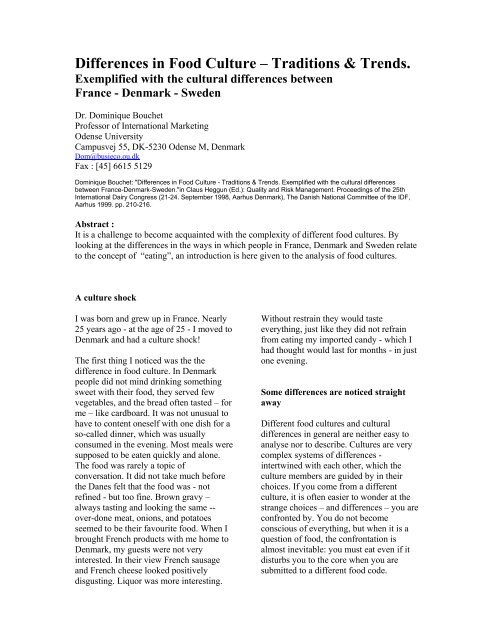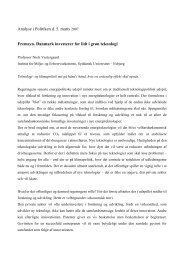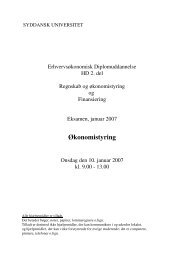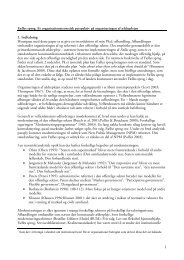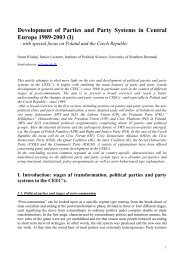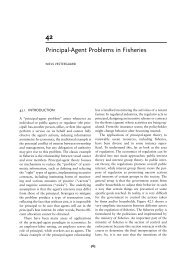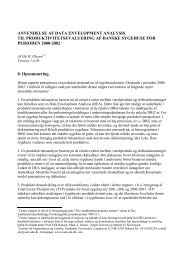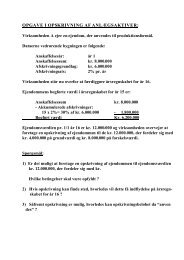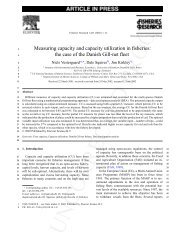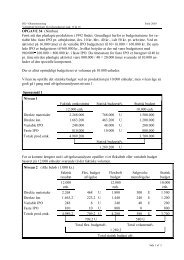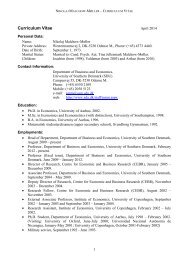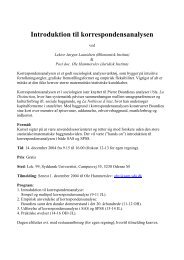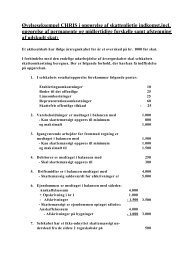Differences in Food Culture - Traditions & Trends. Exemplified
Differences in Food Culture - Traditions & Trends. Exemplified
Differences in Food Culture - Traditions & Trends. Exemplified
Create successful ePaper yourself
Turn your PDF publications into a flip-book with our unique Google optimized e-Paper software.
<strong>Differences</strong> <strong>in</strong> <strong>Food</strong> <strong>Culture</strong> – <strong>Traditions</strong> & <strong>Trends</strong>.<br />
<strong>Exemplified</strong> with the cultural differences between<br />
France - Denmark - Sweden<br />
Dr. Dom<strong>in</strong>ique Bouchet<br />
Professor of International Market<strong>in</strong>g<br />
Odense University<br />
Campusvej 55, DK-5230 Odense M, Denmark<br />
Dom@busieco.ou.dk<br />
Fax : [45] 6615 5129<br />
Dom<strong>in</strong>ique Bouchet: "<strong>Differences</strong> <strong>in</strong> <strong>Food</strong> <strong>Culture</strong> - <strong>Traditions</strong> & <strong>Trends</strong>. <strong>Exemplified</strong> with the cultural differences<br />
between France-Denmark-Sweden."<strong>in</strong> Claus Heggun (Ed.): Quality and Risk Management. Proceed<strong>in</strong>gs of the 25th<br />
International Dairy Congress (21-24. September 1998, Aarhus Denmark), The Danish National Committee of the IDF,<br />
Aarhus 1999. pp. 210-216.<br />
Abstract :<br />
It is a challenge to become acqua<strong>in</strong>ted with the complexity of different food cultures. By<br />
look<strong>in</strong>g at the differences <strong>in</strong> the ways <strong>in</strong> which people <strong>in</strong> France, Denmark and Sweden relate<br />
to the concept of “eat<strong>in</strong>g”, an <strong>in</strong>troduction is here given to the analysis of food cultures.<br />
A culture shock<br />
I was born and grew up <strong>in</strong> France. Nearly<br />
25 years ago - at the age of 25 - I moved to<br />
Denmark and had a culture shock!<br />
The first th<strong>in</strong>g I noticed was the the<br />
difference <strong>in</strong> food culture. In Denmark<br />
people did not m<strong>in</strong>d dr<strong>in</strong>k<strong>in</strong>g someth<strong>in</strong>g<br />
sweet with their food, they served few<br />
vegetables, and the bread often tasted – for<br />
me – like cardboard. It was not unusual to<br />
have to content oneself with one dish for a<br />
so-called d<strong>in</strong>ner, which was usually<br />
consumed <strong>in</strong> the even<strong>in</strong>g. Most meals were<br />
supposed to be eaten quickly and alone.<br />
The food was rarely a topic of<br />
conversation. It did not take much before<br />
the Danes felt that the food was - not<br />
ref<strong>in</strong>ed - but too f<strong>in</strong>e. Brown gravy –<br />
always tast<strong>in</strong>g and look<strong>in</strong>g the same --<br />
over-done meat, onions, and potatoes<br />
seemed to be their favourite food. When I<br />
brought French products with me home to<br />
Denmark, my guests were not very<br />
<strong>in</strong>terested. In their view French sausage<br />
and French cheese looked positively<br />
disgust<strong>in</strong>g. Liquor was more <strong>in</strong>terest<strong>in</strong>g.<br />
Without restra<strong>in</strong> they would taste<br />
everyth<strong>in</strong>g, just like they did not refra<strong>in</strong><br />
from eat<strong>in</strong>g my imported candy - which I<br />
had thought would last for months - <strong>in</strong> just<br />
one even<strong>in</strong>g.<br />
Some differences are noticed straight<br />
away<br />
Different food cultures and cultural<br />
differences <strong>in</strong> general are neither easy to<br />
analyse nor to describe. <strong>Culture</strong>s are very<br />
complex systems of differences -<br />
<strong>in</strong>tertw<strong>in</strong>ed with each other, which the<br />
culture members are guided by <strong>in</strong> their<br />
choices. If you come from a different<br />
culture, it is often easier to wonder at the<br />
strange choices – and differences – you are<br />
confronted by. You do not become<br />
conscious of everyth<strong>in</strong>g, but when it is a<br />
question of food, the confrontation is<br />
almost <strong>in</strong>evitable: you must eat even if it<br />
disturbs you to the core when you are<br />
submitted to a different food code.
The components of food culture<br />
Among the basic differences which the<br />
multiple cultures employ <strong>in</strong> the build<strong>in</strong>g of<br />
their food culture, some are physiological<br />
taste experiences (sweet, salt, sour, bitter,<br />
cold, warm, dry, spicy...). Some have to do<br />
with preparation (raw, boiled, fried...).<br />
Others refer to basic attitudes (ethos)<br />
concern<strong>in</strong>g the relationship with nature and<br />
the universe (pure, unclean, holy, secular,<br />
genu<strong>in</strong>e, healthy, necessary...). Yet others<br />
refer to the social ties (traditional, public,<br />
private, luxurious, festive, everyday-like,<br />
exotic...).<br />
In other words, it is not just what you eat<br />
which is <strong>in</strong>terest<strong>in</strong>g, but also how, when,<br />
with whom, and why. And all these<br />
doma<strong>in</strong>s <strong>in</strong>tersect: everyth<strong>in</strong>g we eat - as<br />
well as the way <strong>in</strong> which we eat it - is<br />
<strong>in</strong>fluenced by all the systems of mean<strong>in</strong>g at<br />
once.<br />
When an <strong>in</strong>novation occurs<br />
If a technological <strong>in</strong>novation is made<br />
which makes new products possible or if a<br />
supplier from abroad tries his luck with<br />
foreign products, the new product will be<br />
viewed accord<strong>in</strong>g to the complex system of<br />
<strong>in</strong>terpretation which makes up a culture.<br />
This happens <strong>in</strong> more or less the same way<br />
as when e.g. car manufacturers wish to f<strong>in</strong>d<br />
out how they can benefit from new<br />
technologies. When the ABS brak<strong>in</strong>g<br />
system was <strong>in</strong>troduced, BMW marketed it<br />
as someth<strong>in</strong>g which enabled the driver to<br />
have even more control of the vehicle.<br />
Volvo, on the other hand, emphasised that<br />
the brak<strong>in</strong>g system meant even more safety<br />
for the passengers.<br />
<strong>Food</strong> cultures, however, are considerably<br />
more complex than brand names.<br />
Therefore, what happens <strong>in</strong> connection<br />
with <strong>in</strong>novation is far less conscious than<br />
the runn<strong>in</strong>g of a bus<strong>in</strong>ess. In addition,<br />
bus<strong>in</strong>esses - no matter which goods they<br />
offer - are not only confronted with<br />
technological <strong>in</strong>novations but also with<br />
cultural changes. The latter are even more<br />
difficult to relate to.<br />
Ecology as an example<br />
The <strong>in</strong>creas<strong>in</strong>g <strong>in</strong>terest <strong>in</strong> ecology and<br />
ecological production methods is an<br />
example of such a cultural change. In this<br />
connection it is observed that ecology<br />
concern<strong>in</strong>g food means someth<strong>in</strong>g<br />
different <strong>in</strong> France and <strong>in</strong> Denmark. With<br />
respect to production methods, i.e. the<br />
relationship between product and nature,<br />
both countries are aware that such products<br />
are gentle to nature. But when the issue is<br />
the relation between the product and the<br />
body, the priorities <strong>in</strong> the two countries<br />
differ: <strong>in</strong> Denmark it is emphasised above<br />
all that the products are healthy, whereas <strong>in</strong><br />
France the ma<strong>in</strong> issue is the better taste.<br />
Thus, a tendency which seems to be shared<br />
and homogenis<strong>in</strong>g, can, on further<br />
analysis, turn out to be multiple and<br />
diverg<strong>in</strong>g.<br />
In the above example the experience seems<br />
to be more important for the French than<br />
the realisation, whereas it is the opposite<br />
for the Danes. Two different rationalities<br />
prevail: the Danish rationality is based on<br />
scientific and juricidal criteria for<br />
evaluation, wheras the French rationality is<br />
dom<strong>in</strong>ated by aestethic - i.e. sensuous -<br />
criteria.<br />
The sensuous and the factual<br />
General cultural criteria are also mak<strong>in</strong>g<br />
themselves felt when consumers relate to<br />
other types of products. If it is a question<br />
of cheese and meat, French consumers<br />
emphasise the sensuous aspect - Danish<br />
consumers the factual. Because the taste<br />
sensation plays such a large role <strong>in</strong> France,<br />
French consumers are less likely to let
themselves be <strong>in</strong>fluenced by e.g. hygienic<br />
arguments, which is a source of wonder for<br />
many Scand<strong>in</strong>avians.<br />
These types of consumer behaviour are<br />
deeply rooted <strong>in</strong> different ways of relat<strong>in</strong>g<br />
to the animalistic - to life and death. Fresh<br />
oysters and red meat are seldom<br />
appreciated <strong>in</strong> Denmark, whereas <strong>in</strong> France<br />
exactly red meat is perceived as be<strong>in</strong>g<br />
more alive, and thereby more powerful and<br />
appetis<strong>in</strong>g.<br />
The animalistic aspect is seen as someth<strong>in</strong>g<br />
positive <strong>in</strong> France and Spa<strong>in</strong>, whereas the<br />
associations <strong>in</strong> Denmark and Germany are<br />
more <strong>in</strong> the direction of death and<br />
morbidity. The reaction is one of disgust,<br />
and therefore it is desirable to kill each and<br />
every trace of what is disgust<strong>in</strong>g <strong>in</strong> a<br />
process of fry<strong>in</strong>g, boil<strong>in</strong>g, or pasteuris<strong>in</strong>g.<br />
Thereby, the animalistic is transformed<br />
<strong>in</strong>to someth<strong>in</strong>g different: the prote<strong>in</strong>s it<br />
consists of. Digg<strong>in</strong>g a little deeper <strong>in</strong>to this<br />
issue, one f<strong>in</strong>ds that there are different<br />
perceptions of the dist<strong>in</strong>ction between the<br />
human and the animalistic which support<br />
the experience of the consumer <strong>in</strong> their<br />
respective cultures. In the Nordic countries<br />
people talk more about nature <strong>in</strong> man than<br />
about culture versus nature, just like many<br />
people try to behave naturally. Contrary to<br />
that, people <strong>in</strong> Catholic countries are fond<br />
of rhetoric and pomp and gladly make use<br />
of culture and stag<strong>in</strong>g for seduction.<br />
The food cultures <strong>in</strong> France and<br />
Denmark<br />
The French use food more <strong>in</strong>tensively as a<br />
means of communication, because they<br />
share a code <strong>in</strong> which both food and<br />
language play an important role. The<br />
mastery of the shades of the French<br />
language and the appreciation of the<br />
pr<strong>in</strong>ciples of the French kitchen are the key<br />
to the <strong>in</strong>tegration <strong>in</strong> a community <strong>in</strong> which<br />
one both feels welcome and has the<br />
possibility to move up <strong>in</strong>dependent of<br />
occupation as well as social status. The<br />
references - the food ideal - are practically<br />
the same for all sections of the population.<br />
In Denmark too, roughly the same food<br />
ideal is shared across social groups.<br />
However, that ideal does not have the same<br />
content or significance as <strong>in</strong> France. <strong>Food</strong><br />
and language are not employed to the same<br />
degree <strong>in</strong> order to show off an expertise,<br />
the food rituals are less impos<strong>in</strong>g. In<br />
Denmark one is <strong>in</strong>cluded <strong>in</strong> the community<br />
without necessarily tak<strong>in</strong>g an <strong>in</strong>terest <strong>in</strong><br />
food.. It is acceptable to eat alone and<br />
hurriedly on a frequent basis, and there are<br />
fewer occasions for eat<strong>in</strong>g together, and<br />
even fewer for exquisite meals.<br />
Thus, the food rituals function differently.<br />
In Denmark a pronounced sense of the<br />
matter of course and <strong>in</strong>difference rules,<br />
everybody is accepted irrespective of<br />
<strong>in</strong>dividual taste. In France everybody has<br />
to confirm their state of membership and<br />
secure their place by show<strong>in</strong>g a<br />
commitment as well as a knowledge of<br />
taste and aesthetics. But, as mentioned, not<br />
very much <strong>in</strong> both countries dist<strong>in</strong>guishes<br />
the food ideals of the various social<br />
groups.<br />
Swedish multiplicity<br />
Matters stand differently <strong>in</strong> Sweden where<br />
the French aristocratic food ideal rules <strong>in</strong><br />
one part of the population, and Danish-like<br />
popular food ideals <strong>in</strong> another.<br />
Compared to the situation <strong>in</strong> France and<br />
Denmark, the Swedish food culture is less<br />
homogenous. It refers less to the national<br />
community and has a higher degree of<br />
complexity from local and group-specific<br />
codes. Thus, the Swedish and French food<br />
cultures share the demand for a<br />
confirmation of a person’s affiliation. But<br />
only <strong>in</strong> few groups do taste and<br />
sensuousness play a central role. In<br />
general, the nutritional and the natural<br />
aspects take up the most central place
across all groups of identification. Unlike<br />
Denmark, they are mov<strong>in</strong>g away from<br />
hav<strong>in</strong>g common references and are go<strong>in</strong>g<br />
<strong>in</strong> the direction of natural rather than<br />
practical characteristics, and the taste<br />
preferences refer less to personal than to<br />
natural and simple aspects.<br />
At a sem<strong>in</strong>ar where the food was prepared<br />
by a proud French cook, the Danish<br />
participants critisised the uniformity of the<br />
food with reference to people’s <strong>in</strong>dividual<br />
taste. The Swedes deplored the fact that the<br />
food was too exquisite, they would have<br />
preferred a sliced tomato and a grilled fish.<br />
The French participants, however, made<br />
extensive comparisons to previous food<br />
experiences.<br />
milk-free omelet. The Frenchman remarks<br />
that he prefers this k<strong>in</strong>d of discrete service<br />
to what he has experienced <strong>in</strong> the United<br />
States where the staff with a stiff plastic<br />
smile would <strong>in</strong>elegantly <strong>in</strong>terrupt the meal<br />
at any given time with an importunate and<br />
agressive “Good day, sir. My name is<br />
Peter. How is everyth<strong>in</strong>g?” The Swedish<br />
<strong>in</strong>formal form of service pleases the<br />
Frenchman who perceives the American<br />
formalism <strong>in</strong> that area as an <strong>in</strong>terruption of<br />
the <strong>in</strong>timity and <strong>in</strong>tensity of the meal<br />
where the <strong>in</strong>trusion of the waiter breaks the<br />
spell. The Dane, on the other hand, who<br />
also perceives the waiter’s smile as be<strong>in</strong>g<br />
false, primarily notices the the falseness<br />
rather than the lack<strong>in</strong>g consideration of the<br />
social aspect of the meal.<br />
The perception of service<br />
The differences <strong>in</strong> food cultures are also<br />
expressed <strong>in</strong> other ways, which can be<br />
illustrated as follows:<br />
A Dane, a Frenchman and an American<br />
met for breakfast <strong>in</strong> a Stockholm hotel.<br />
The American stops <strong>in</strong> front of the table<br />
where the waitress is prepar<strong>in</strong>g omelets.<br />
He tells her that he is allergic to dairy<br />
products and asks if that particular omelet<br />
conta<strong>in</strong>s milk. The Swedish waitress does<br />
not appear to react. She does not answer<br />
but turns her back and walks off to make a<br />
new omelet. While the American is<br />
express<strong>in</strong>g his surprise and disappo<strong>in</strong>tment<br />
through his body language, he sees a<br />
different table with hard-boiled eggs.<br />
“Never m<strong>in</strong>d”, he says <strong>in</strong> a firm and<br />
irritated voice, “I’ll just have a hard-boiled<br />
egg.” But the waitress does not register<br />
this. She seems to be lost <strong>in</strong> her own<br />
thoughts. While the three colleagues are<br />
fill<strong>in</strong>g their plates from the buffet, the<br />
Dane comments on the lack<strong>in</strong>g<br />
qualifications of the waitress.<br />
Three m<strong>in</strong>utes later the waitress comes to<br />
their table where, discretely and without<br />
any comment, she serves the American a<br />
Planet system or commode<br />
A great deal of the categories which are<br />
used more or less consciously for an<br />
evaluation of the quality of food and meals<br />
are not objective. Their mean<strong>in</strong>gs are<br />
connected <strong>in</strong> a culture-specific structure<br />
which has more <strong>in</strong> common with a mobile<br />
planet system than with a well-organised<br />
commode consist<strong>in</strong>g of well-separated<br />
drawers. Quality, formalism, authenticity<br />
refer to widely different culture-specific<br />
comb<strong>in</strong>ations. The authenticity, for<br />
<strong>in</strong>stance, which Danes seek <strong>in</strong> a meal is<br />
often a relaxed atmosphere, whereas<br />
Swedes will primarily seek someth<strong>in</strong>g of<br />
that sort <strong>in</strong> purely natural products.<br />
Accord<strong>in</strong>gly, it ought to be clear that it<br />
does not suffice to make superficial<br />
analyses of <strong>in</strong>dividual dimensions, set up<br />
<strong>in</strong>dependently of each other <strong>in</strong> a commodelike<br />
chart where the familiarity forms, the<br />
social aspect, and the taste are taken out of<br />
context. All dimensions are not only<br />
closely connected, they are also <strong>in</strong>tricately<br />
connected like a hologramme. As a<br />
summary, <strong>in</strong> Table 1 I have tried to<br />
illustrate some of the <strong>in</strong>tra-cultural<br />
<strong>in</strong>teractions mentioned <strong>in</strong> this article.
Table 1: How priorities differ <strong>in</strong> the three countries:<br />
TOPICS OF FOCUS/<br />
CULTURES<br />
FRANCE DENMARK SWEDEN<br />
<strong>Food</strong> Taste Nutrition Nutrition<br />
Meal<br />
The most important aspect<br />
of the meal<br />
<strong>Food</strong> formalism<br />
Taste preferences<br />
Taste/the social bond<br />
Possible social tie<br />
Taste sensation..<br />
Sensous experience<br />
Social <strong>in</strong>teraction<br />
Cultural characteristics<br />
Taste<br />
High aesthetic priority<br />
• More important than<br />
hygiene<br />
• Social bond<br />
• Sensous<br />
Carrier of social bonds<br />
Cultural code expressed<br />
through speech<br />
National conformism<br />
Differentiation by<br />
means of ref<strong>in</strong>ement<br />
Physiological necessity<br />
Individual pause<br />
Nutrients<br />
Personal pleasure<br />
Practical characteristics<br />
Low aesthetic priority<br />
• Secondary to hygiene<br />
• Individual choice<br />
• Nutritional<br />
Personal pleasure<br />
Cultural code very<br />
seldom expressed<br />
Simple and tolerant<br />
code<br />
The legitimacy of simple<br />
taste<br />
Natural necessity<br />
Individual pause<br />
Nutrients<br />
Personal pleasure<br />
Natural characteristics<br />
Medium aesthetic<br />
priority<br />
• Secondary to hygiene<br />
• Naturally rooted<br />
• Natural<br />
Dependent on social<br />
group<br />
Cultural code<br />
occasionally expressed<br />
Simple and tolerant code<br />
The legitimacy of natural<br />
taste<br />
Relative differentiation<br />
Sourish or mixed taste Seen as archaism Very widespread Very widespread<br />
<strong>Food</strong> talk<br />
<strong>Food</strong> talk - when?<br />
<strong>Food</strong> talk - who talks the<br />
most?<br />
<strong>Food</strong> talk - what about?<br />
The decisive aspect of the<br />
relation to taste<br />
When buy<strong>in</strong>g food<br />
The rhythm of meals<br />
Restaurant<br />
Industrialisation of food<br />
production<br />
Very extensive<br />
Wordy<br />
Already while shopp<strong>in</strong>g<br />
Even more at the table<br />
Demand<br />
Questions<br />
Taste experiences<br />
<strong>Food</strong> experiences<br />
• Be<strong>in</strong>g able to dist<strong>in</strong>guish<br />
the good taste<br />
• Be<strong>in</strong>g able to express<br />
slight dist<strong>in</strong>ctions<br />
See<strong>in</strong>g, touch<strong>in</strong>g,<br />
smell<strong>in</strong>g<br />
Commensal (community<br />
based on food)<br />
The art of food<br />
The social aspect<br />
Damages taste<br />
• Loss of taste<br />
• Banalis<strong>in</strong>g, levell<strong>in</strong>g of<br />
products<br />
• Loss of cultural<br />
identity (upbr<strong>in</strong>g<strong>in</strong>g,<br />
“terroirs”)<br />
Weak<br />
Laconic<br />
Very rarely while<br />
shopp<strong>in</strong>g<br />
Rarely at the table<br />
Supply<br />
Brochures<br />
Safety and health<br />
Individual taste<br />
• Correspond<strong>in</strong>g to a<br />
person’s <strong>in</strong>dividual<br />
taste<br />
• No explanations<br />
Perhaps read about it<br />
Physiological<br />
Hygiene<br />
Service<br />
Usually rational<br />
Seldom <strong>in</strong>jurious to<br />
health<br />
• Distribution of norms<br />
for security<br />
• Shorten<strong>in</strong>g of<br />
preparation time<br />
• Easy-to-use<br />
Weak<br />
Laconic<br />
Rarely while shopp<strong>in</strong>g<br />
Rarely at the table<br />
Supply<br />
Brochures<br />
The natural and health<br />
Individual taste<br />
• Natural, correspond<strong>in</strong>g<br />
to a person’s <strong>in</strong>dividual<br />
taste<br />
• No explanations<br />
Perhaps read about it<br />
Physiological<br />
Hygiene<br />
The social aspect<br />
Mostly rational<br />
At times <strong>in</strong>jurious to<br />
health<br />
• Distribution of norms<br />
for security<br />
• Shorten<strong>in</strong>g of<br />
preparation time<br />
• Distortion of the natural
Ecological products<br />
For taste reasons<br />
Terroir<br />
For health reasons<br />
Pollution<br />
Meat Life Death Death<br />
For health reasons and<br />
because of the natural<br />
aspect<br />
Pollution<br />
Preparation of meat Red meat because of its Well-done for safety Well-done for safety<br />
powerfulness<br />
reasons<br />
reasons<br />
Cheese Alive Pasteurised Pasteurised<br />
Eat<strong>in</strong>g cheese<br />
Room temperature<br />
Gourmet<br />
Tasted with w<strong>in</strong>e and<br />
bread<br />
Development of the<br />
product<br />
National taste<br />
classification system<br />
Chilled<br />
Standardised<br />
Rigid norms<br />
Unvary<strong>in</strong>g taste<br />
<strong>Food</strong> code<br />
No reference to a shared<br />
classification system<br />
Ma<strong>in</strong> reference <strong>Culture</strong> Nature Nature<br />
Chilled<br />
Standardised<br />
Rigid norms<br />
Unvary<strong>in</strong>g taste<br />
No reference to a shared<br />
classification system<br />
Historical <strong>in</strong>fluence Aristocratic Peasantry Different sources:<br />
Aristocracy or peasantry<br />
and/or the work<strong>in</strong>g<br />
classes


